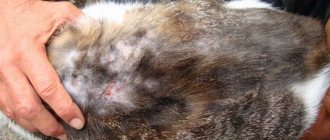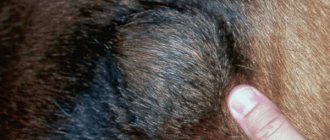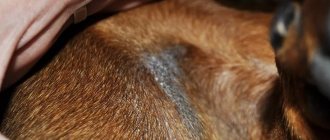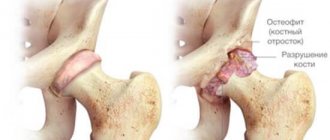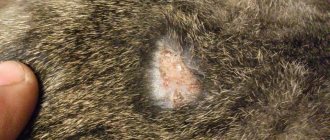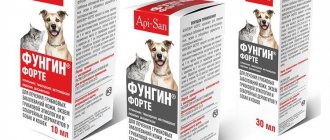All breeds of our four-legged friends are susceptible to a disease such as pyoderma in dogs. However, predominantly purulent accumulations on the skin affect Shar Peis, Mastino Neapolitans, Bullmastiffs, Chow Chows, Boxers, Chihuahuas, English and French Bulldogs.
The disease makes itself known with obvious signs that cannot be ignored. Therefore, at the first discovery of them, the dog owner should take him to a veterinary clinic to see specialists in order to promptly begin treatment for pyoderma, which is not such a harmless disease.
Etiology of the disease pyoderma in dogs
Pyoderma or, as this disease is also called, pyoderma, pyodermitis, is usually provoked by staphylococci, streptococci, pneumococci, and Pseudomonas aeruginosa. Its intensity depends on the state of immunity. All these bacteria are conditionally pathogenic, that is, they are always present on the skin of the animal and, under any favorable conditions, are capable of beginning their negative impact. In addition, a dog can “pick up” bacteria through airborne droplets or through food, household contact, and even in a veterinary clinic, where they do not disinfect areas where animals are received.
If left untreated, a chronic form of pyoderma is inevitable, which has a detrimental effect on the animal’s body for years. The pathology in question can be provoked by:
- a sufficiently long stay of the pet in extremely warm and humid conditions;
- a sharp transition from one diet to another and nutritional errors;
- helminthic infections;
- excessive fatigue from active physical activity or lack of mobility;
- the presence of skin damage in the form of wounds, scratches, microcracks, cuts;
- not caring for the animal’s skin or lack of it at all;
- allergic reactions;
- splinters or thorns, abrasions from gravel and sand, burns that affect the pads of the paws on walks.
The disease is especially affected by the accompanying ailments:
- diabetes mellitus in dogs;
- exhaustion;
- intestinal diseases;
- disruptions in hematopoiesis and circulation;
- the presence of ticks and fleas in the skin.
The process itself occurs mainly 3-5 days after the pet’s skin has been injured. Pathogenic bacteria begin their action on it, causing itching and inflammation. The dog itches, spreading them further along the skin, which in infected areas (this can be the peritoneum, the area near the genitals, muzzle, skin folds) becomes covered with a rash (papules) with purulent contents. Papules burst over time, turning into erosions.
If therapy is not started on time or is carried out poorly, superficial pyoderma in dogs quickly turns into deep pyoderma, which makes itself felt by significant ulcerative lesions that emit an unpleasant putrefactive odor. The same thing happens when the interdigital areas of the paws are affected.
The disease is dangerous because with deep damage, pus penetrates into the blood, poisoning the animal’s body and thus disrupting its functioning. The kidneys and liver are primarily affected.
Intertrigo
This is a type of pyoderma, a lesion of the dermis in the folds of the skin. Animals with overhanging skin that forms folds are susceptible to the disease. The infection worsens in hot weather and high humidity.
Which breeds are at risk?
All breeds of dogs that have loose skin with folds on the body: Shar-Pei, Mastino Neapolitan, Chihuahua, bulldog. Intertrigo occurs if the animal’s skin is not cared for regularly and basic rules of personal hygiene are not followed.
Development factors
If a dog has clumps of fur (tangles) or folds, then in wet weather or after an active walk the skin under them begins to swell. In warm and humid environments, staphylococci develop, which leads to infection.
If the animal's skin inside the folds is not regularly wiped and treated, this will also lead to the development of pyoderma.
Prevention
- Trim long hair regularly and carefully inspect the animal's skin.
- Pay special attention to the folds of the skin, as these are where a large number of microorganisms most often accumulate. In hot weather, sweat can accumulate in the folds and, as a result, eczema develops.
- Your pet should always have a complete, balanced diet, vitamins and microelements. Consult your veterinarian about the advisability of purchasing special vitamin complexes for your dog.
- If possible, it is necessary to eliminate all factors that can provoke an infectious process in the pet’s body.
- On the streets, do not allow your dog to come into contact with suspicious animals.
- If your pet is susceptible to allergic reactions, regularly carry out allergy prevention - select appropriate hair care products with your veterinarian, eliminate food allergens and the dog’s contact with household chemicals.
Any disease is much easier to prevent, so take care of your pet’s health every day, do not ignore the symptoms, even if they seem insignificant to you. Treatment of pyoderma requires long-term use of antibiotics, which are dangerous due to a wide range of side effects. Prevent your four-legged friend from getting sick, thereby making life easier for your pet and yourself.
Causes of the disease
Pathogenic microorganisms that cause the disease are conditionally pathogenic, since they are constantly present on the skin of the animal. Their impact begins when certain conditions arise.
In most cases, the disease develops in animals with weakened immune systems or as a result of the dog receiving skin injuries.
Minor wounds, scratches, splinters or burns cause the development of interdigital pyoderma.
The disease develops as a result of exposure to unfavorable external factors, such as high humidity, infection with skin parasites that accumulate in the neck, groin, tail or chest.
Dogs with long hair are prone to pyoderma, which, if not properly cared for, becomes matted and becomes a site for the reproduction and development of pathogenic bacteria.
A dog can become ill as a result of a change in diet or a lack of nutrients in the food.
Also, the causes of damage are infection with intestinal parasites, allergic reactions, insufficient physical activity or heavy physical exertion.
Interdigital pyoderma can result from long walks on hot sand or small stones.
Symptoms
The pathology is quite serious, so its general symptoms are highlighted, corresponding to all types of this disease, when they appear, immediate action must be taken:
- the dog shows indifference and absolute weakness;
- refuses food;
- the affected areas are itchy and painful;
- vesicles with purulent fluid inside or it pours out, forming erosions;
- Infected areas give off an unpleasant odor due to open purulent wounds.
Such symptoms are a reason to take your pet to the veterinarian in order to detect the presence of bacterial enzymes using bacterial culture. The disease can last for years, and if help is not provided in a timely manner, purulent formations will slowly poison the dog.
Signs of the disease
Pyoderma begins with simple itching, and later an unpleasant odor appears. The animal constantly itches, even at night, whines, squeals, and becomes nervous.
Over time, the affected area becomes covered with a rash, turns red, and purulent papules appear. The abscesses open and seals form in their place.
Deep pyoderma is characterized by local skin damage, the development of ulcers, erosions, crusts, and fistulas. In advanced cases, sepsis, fever, and fever are possible.
Types of pyoderma
There are several types of this skin disease in dogs. The appearance of one type or another depends on the breed and age of the animal, as well as the nature of the inflammatory process and the affected area. Taking this into account, pyoderma occurs:
- interdigital
- occurs not only from injury, but can also be triggered by parasites, fungal infections, punctures and cuts of the skin, burns; - callus
- formed when the immune system is weakened, superficial damage to the skin tissue or malfunction of the thyroid gland. The malaise mainly occurs in pets belonging to large breeds. They are affected by the skin over a large joint; - superficial itchy folliculitis
- with seborrhea or excessive skin sensitivity, which usually occurs in short-haired animals. They itch almost all day long, resulting in extensive bald patches that indicate the disease. If the dog’s immunity is excellent, folliculitis may go away on its own; - impetigo
- manifests itself mainly in puppies. Inflammation with pink-colored watery blisters penetrates into the deep layers of their skin. The places where they burst make themselves felt by the formation of yellowish scabs; - pyoderma of skin folds
- the name of this type clearly identifies the affected areas. Often in females, the disease manifests itself in the folds of the genital organs, and the breed of the animal does not matter; - acute dyshidrotic dermatitis
- which is a wet area with a characteristic specific odor, formed against the background of severe itching and scratching.
Clinically, pyoderma manifests itself in three forms:
- superficial
- spreads in the upper layer of the skin and is characterized by slight hair loss in the affected area; - shallow
– affects the deeper layers of the epidermis, including the follicles of the coat; - deep
- penetrating into deeper areas of the skin, down to the muscle-fat layer, and transforming bald spots in places with bleeding wounds.
Diagnostics
Although this disease has fairly recognizable symptoms, no one will treat pyoderma in dogs if purulent rashes are detected. After all, similar signs can also arise in the case of:
- skin lesions by microscopic mites (demodex);
- plague;
- various fungal infections of the skin.
An accurate diagnosis is determined only as a result of a comprehensive study:
- blood test;
- cultures that determine the causative agents of purulent lesions;
- scrapings that reveal parasites (Demodex);
- allergy tests (if the onset of the ailment was caused by allergic dermatitis).
If necessary, a hormonal study may be required - after all, such skin inflammations also occur in cases of dysfunction of the thyroid and adrenal glands.
Diagnostics in a veterinary clinic
Diagnosing the disease is difficult, since symptoms may indicate not only pyoderma, but also other skin diseases (plague, demodicosis, dermatomycosis, etc.). In addition to a visual examination of the dog, the veterinarian will need to conduct a biochemical blood test, examination of purulent discharge, culture of blood scrapings, and allergy tests.
Bacterial culture is carried out to determine the type of microorganisms that caused pyoderma, as well as their sensitivity to antibiotics. The procedure is unpleasant for the animal, but it must be done. The result will be known in a few days.
What to do at home
Under no circumstances should you self-medicate. Traditional methods based on the use of medicinal herbs can only worsen the dog’s condition.
The owner will be required to make adjustments to the maintenance of the pet and provide it with good care. Walks should not be cancelled, but they should be shorter and calmer. Physical activity should be excluded during treatment.
When caring for your pet, you need to use gloves, since pyoderma can be transmitted to people through purulent exudate.
The food should be dietary, dry food and especially food should be excluded from your table. It is advisable to feed a recovering dog porridge with lean meat or liver.
To enhance immunity, special vitamin complexes are used, which are prescribed by a veterinarian. Drugs such as Katozol, vitreous, etc. are indicated.
Treatment of pyoderma in dogs
The therapeutic process for this disease is long and complex. Not all dog owners can tolerate it. Previously, even for this reason, it was believed that pyoderma could not be cured. Now all doubts and rumors have been put aside. If the doctor's orders are properly followed, the ailment can be treated successfully. Therapeutic methods and drugs are prescribed in accordance with:
- forms of the disease;
- size and intensity of the lesion;
- general condition and age characteristics of the animal.
Thus, with superficial pyoderma, a positive result can only be achieved using external antimicrobial agents, as well as immunostimulants. But with a deep form of pathology, it will be necessary to endure a difficult therapeutic period.
If treatment of pyoderma in dogs with antibiotics is prescribed, the course of treatment cannot be interrupted, which is usually done when the first signs of the disease go away. After all, relapses may occur, and microorganisms will show resistance to this drug.
Typically, therapy for this ailment involves the following procedure:
- relief from itching;
- preparing the skin for subsequent treatment (removing hair, removing scabs and crusts after they have been soaked, cleaning pus);
- healing effects on wounds with healing and antimicrobial agents - creams and ointments Fucicort, Lorinden, Travocort, Celestoderm
; - if necessary, antibiotic therapy is carried out - medications are periodically changed, one type is not used for more than 5-7 days, and the systemic antibiotic should not be the same as that used in ointments. Injections are given intramuscularly into the thigh - Baytril, Tylosin, Cephalexin, Enrofloxacin, Erythromycin, Lincomycin, Clindamycin
; - drugs that enhance immunity are prescribed - Pyrogenal, Cycloferon, Immunofan
; - in case of protracted and chronic processes, detoxification is mandatory.
You should know that pyoderma in dogs is a contagious pathology. Therefore, all therapeutic techniques when treating a dog should be carried out wearing gloves and preferably using a face mask.
Prevention of disease in dogs
An illness fraught with serious consequences. So, scars and scars remain on the skin. The disease severely undermines the dogs' immune system. Even if the therapy was successful, there is no complete relief from it. In any case, regular relapses will constantly make themselves known. For this reason, preventive measures are of great importance, including:
- strengthening the general health of the pet through the use of vitamin and mineral preparations;
- refusal of dry food during the period after painful recovery;
- paying attention to any changes in the skin and mandatory consultation about this with a specialist;
- providing a balanced diet for your pet;
- constant care for the condition of his skin only with the use of antimicrobial shampoos;
- prevention of skin injury, and in the event of even minor microtraumas, mandatory treatment with solutions of methylene blue, iodine, Nitrofural spray
; - preventing your pet from coming into contact with stray animals;
- constant attention to the health of the pet and treatment of ailments that contribute to a decrease in immunity.
Of course, these measures do not guarantee 100% protection against purulent lesions such as pyoderma. But the risk of contracting this pathology will still be less.
Pyoderma, as we see, is a rather complex infectious disease of a dog’s skin, which negatively affects its health both externally and internally. It is important to identify the disease in time and begin treatment in order to prevent its consequences. After all, for simple forms of pathology the prognosis is always good. Therefore, be attentive to your pet and do not miss the opportunity to save him from this not so simple pathology.
Currently reading:
- The insidiousness of canine atopy: is there any hope for recovery?
- Thyroid dysfunction in dogs (hypothyroidism)
- The most common skin diseases in dogs
- Is it possible to treat pododermatitis on your own in a dog?
How to care for a sick dog
Treatment of pyoderma is a long process. Recovery may occur only several months after the start of therapy. The animal must be switched to a balanced diet.
If your dog suffers from allergic reactions, you can choose hypoallergenic food.
Also, during treatment, increased stress is excluded, walks should be calm. All veterinarian instructions must be followed. Any deviation from the treatment regimen may lead to a worsening of the condition.
Diagnosis and treatment
Veterinarians make a diagnosis of “Pyoderma” based on examination and laboratory diagnostics, which is carried out using the most advanced technologies. If the animal shows clinical signs of illness and skin samples show increased numbers of bacteria and inflammatory cells, treatment is prescribed, which can take from two weeks to several months. During the course, veterinarians must solve the following tasks:
- reduction in the number of pathogens;
- increasing immunity;
- elimination of pus;
- elimination of itching and healing of affected skin.
Treatments
To achieve the desired effect, antibiotic therapy and treatment of the affected areas with ointments, shampoos and sprays is carried out. In especially severe cases, a drip may be required to remove pus from the body, and to eliminate accumulated toxins.
In the case of chronic pyoderma, when it is difficult to identify the underlying cause of the disease, antibiotics are prescribed for a long time as maintenance treatment. In order to prevent a relapse of the disease, the dog must complete the entire course prescribed by the veterinarian in full. Without qualified help, the disease can continue for years - the animal’s body will not be able to cope with the disease on its own.
Careful care of your pet will help to avoid the development of such diseases, but if your pet does get sick, the Best veterinary clinic is always ready to help him!
